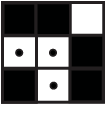Label
Label connected components in binary image
Libraries:
Computer Vision Toolbox /
Morphological Operations
Description
The Label block finds and labels the connected components or objects in a 2-D binary image. The block ignores the background pixels in the input image and searches for connected components within remaining pixels. The block then labels all the pixels of each connected component with a unique number and computes the number of labeled objects.
Examples
Ports
Input
Output
Parameters
Block Characteristics
Data Types |
|
Multidimensional Signals |
|
Variable-Size Signals |
|
Extended Capabilities
Version History
Introduced before R2006a
See Also
Blocks
- Dilation | Erosion | Opening | Closing | Blob Analysis
Functions
bwconncomp|bwselect|regionprops|bwlabel|bwlabeln



